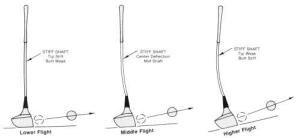Have you ever wondered how understanding the distance each golf club can achieve might transform your golf game? Mastering a golf club distance chart is an essential skill for any golfer, regardless of whether you are a novice or an experienced player. This guide provides valuable insights into using these charts to improve strategic decision-making on the course, thus refining your overall performance.
Understanding the Basics of a Golf Club Distance Chart
A golf club distance chart is a strategic tool that provides average yardages for each club in your bag. It serves as a foundational guide to help you choose the right club based on the distance between you and the hole. Understanding these basics can dramatically improve your game by allowing you to plan your shots more effectively.
Why Use a Golf Club Distance Chart?
Knowing exactly how far each of your clubs can drive the ball is central to strategic play. A golf club distance chart facilitates this understanding, enabling you to make informed decisions. This tool eliminates guesswork and can be especially valuable in unfamiliar courses or under varying weather conditions, offering you the confidence to choose the right club for every shot.
How Are Distances Determined?
Golf club distances are typically determined by an average of several swings with each club, under consistent conditions. Factors such as swing speed, strength, and technique play integral roles in these measurements. While a standard distance chart can serve as a useful baseline, personal adjustments might be necessary to account for individual playing styles and conditions.
| Club | Male Average Distance (Yards) | Female Average Distance (Yards) |
|---|---|---|
| Driver | 230-275 | 200-230 |
| 3-Wood | 210-230 | 170-200 |
| 5-Wood | 195-210 | 150-170 |
| 3-Iron | 180-210 | 140-170 |
| 4-Iron | 170-200 | 130-160 |
| 5-Iron | 160-190 | 120-150 |
| 6-Iron | 150-180 | 110-140 |
| 7-Iron | 140-170 | 100-130 |
| 8-Iron | 130-160 | 90-120 |
| 9-Iron | 120-150 | 80-110 |
| Pitching Wedge | 100-135 | 70-100 |
| Sand Wedge | 80-110 | 60-80 |
| Lob Wedge | 60-90 | 40-60 |
Customizing Your Distance Chart
While generic charts provide a useful foundation, customizing your distance chart to reflect personal metrics can enhance game precision. Adjustments can ensure it aligns with your unique strengths and weaknesses.
Conducting a Personalized Yardage Test
One approach to personalizing your distance chart is to conduct a yardage test. By hitting multiple balls with each club at the driving range and recording the distances, you can establish a personal average that takes your unique swing style and power into account. It is important to conduct these tests under consistent conditions to ensure accuracy.
Factors Influencing Club Distance
Recognizing the other factors that influence how far you hit can enable better customization of your chart. These factors include:
- Weather Conditions: Wind, humidity, and temperature can significantly affect shot distance.
- Course Elevation: Courses at higher elevations often allow golf balls to travel further.
- Swing Technique: Club path, speed, and contact accuracy are critical to determining distance.
- Physical Condition: Your health and fitness levels can influence swing power and consistency.

Applying Your Golf Club Distance Chart on the Course
Integrating your distance chart into your gameplay involves more than having an accurate measure of your club distances. It requires strategic thinking and keen awareness during every round.
Pre-Shot Routine and Club Selection
A disciplined pre-shot routine can benefit from the integration of your club distance chart. Before each shot, assess the distance to your target. Cross-reference this with your chart to make a calculated decision about club selection, taking into account conditions such as wind or obstacles.
Adapting to Course Dynamics
Different courses present diverse challenges, each affecting club distance in unique ways. Employing your club distance chart should include considerations of course layout, hazard placement, and even turf conditions. Adjust your expectations based on practical experiences during the round, continually refining your understanding of club performance.
Mental Strategy and Confidence
Finally, using a golf club distance chart strategically means also building mental resilience. Confidence in your club selection can reduce doubt and hesitation, enhancing your focus and overall performance. A sense of certainty allows you to approach each shot with the belief that you have chosen the best possible option.
Regular Updates and Revisions of Your Distance Chart
Commitment to accuracy demands regular updates and revisions of your distance chart. Over time, changes in equipment, physical condition, or even technique can alter your distances.
Periodic Testing and Calibration
Set aside regular sessions for testing each club’s distance. Whether quarterly or bi-annually, these checks ensure your chart’s reliability. Pay attention to any noticeable shifts, especially following significant changes in your play style or after acquiring new clubs.
Embracing Technology
Advancements in golf technology, such as launch monitors and tracking devices, offer precise data for enhancing your distance chart. These devices provide insights into ball speed, launch angle, and club path, helping you make informed adjustments to your assessments.

Benefits of Mastering Your Golf Club Distance Chart
Effectively utilizing a golf club distance chart offers more than just improved club selection. It encompasses several benefits that contribute to a well-rounded game.
Enhanced Accuracy and Consistency
Accurate club distance facilitates more precise shot-making, allowing you to approach greens with confidence and minimize missed targets. Consistency in distance allows for better strategic planning and execution throughout the round.
Increased Strategic Depth
Understanding the nuances of your individual distances enhances your ability to strategize across varying course layouts. You can adopt different tactics that exploit your strengths and compensate for weaknesses, customizing your approach to suit each hole’s demands.
Reduced Handicap
Over time, mastering your golf club distance chart can lead to a decreased handicap. Improved club selection can translate to lower scores and a more polished, competitive game.
Conclusion
In conclusion, mastering your game with a golf club distance chart necessitates both foundational knowledge and personal adaptation. By understanding standard distances and customizing these measures based on your individual play style, you can elevate your strategic decision-making on the course. Regular updates and informed adaptability will further fortify your approach. Thus, equipping yourself with a meticulously crafted golf club distance chart not only transforms your game but also boosts your confidence, accuracy, and overall enjoyment of golfing.











